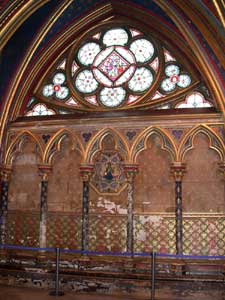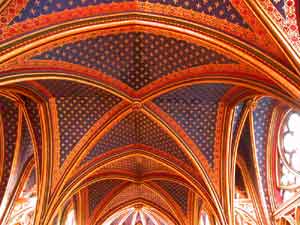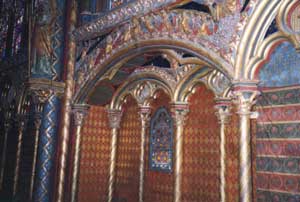|
La Sainte-Chapelle
|
|
Historique
|
|
Saint Louis
|
|
Chapelle Basse
|
|
Chapelle Haute
|
|
English page
|
|

|
Aussi à Paris ...
|
|
Cathédrale Notre-Dame
|
|
L'église Saint Germain l'Auxerrois
|
|

|
|
|
History
 |
Sainte Chapelle could be considered
a huge reliquary built to house the relics of the Crucifixion.
In 1239, Saint Louis bought the crown of thorns from Venetian merchants
for 135,000 Pounds. Fragments of the Holy Cross fragments as well as instruments
of torture were bought from Baudoin II, king of Jerusalem in 1241.
Saint Louis did not want these holy relics to be scattered. |
|
Such precious relics deserved to be sheltered in a special
place. Hence, Saint Louis chose to have a church built inside
the Royal Palace on Cité isle in order to emphasize
the close relationship between the Holy Relics and the monarchy
(that palace was later replaced later by the Law Courts building).
Indeed, building Sainte Chapelle was not only an act of faith;
it was also a political deed.
The church, which has two levels, was consecrated on April
26th, 1248, so it is assumed that Sainte Chapelle was finished
at this time. The starting date, however, is still unknown,
as is the name of the master mason is also (probably Pierre
de Montreuil or Jean de Chelles).
|
|
 |
The ground level was dedicated to parish
services and the relics were kept on the upper level, which
was directly connected to the aula, the main council room. This
arrangement was probably inspired by Charlemagne's palace in
Aachen. Other buildings were later added to Sainte Chapelle.
An annex built on the northern side was destroyed in 1777, and
there was a staircase which enabled people to reach the upper
level on the southern side. From that time on, a choir screen
was added to isolate clergymen and upper class people from common
people. |
|
Sainte Chapelle suffered from several fires
(1630, 1777) and one flood. Nor did the French Revolution
spare it: the outside ornamentation was damaged, especially
the spire, whose fleurs-de-lis were considered a symbol of
the French monarchy. Then, during the First Empire, the upper
chapel was used as an archive warehouse, which led to severe
damage and the stained glass windows were dismantled.
Dead souls rise from their grave, Musée
de Cluny, Paris
|
|
 |
Restorations were made in the second part of the 19th
century, led by the architects Félix Duban (from 1836
to 1848), Jean-Baptiste Lassus (from 1848 to 1857) and Emile
Boeswillwald. Viollet-le-Duc occasionally cooporated with
them without ever leading the project. The remains of the
above mentioned staircase were destroyed (1849) and a new
spire was built (1853). In 1857 restoration of the inside
ornamentation was almost complete.
Virgin with Child, from Sainte Chapelle treasure, Musée
du Louvre, Paris
|

|
| There was much public debate regarding the restoration
and several medievalists were consulted. In opposition to Viollet-le-Duc's
theories, it was decided not to focus on the primitive state
of the chapel but rather to consider every life stage of the
monument. |
| Several choices were difficult, especially
concerning the spire. It is not sure that the primitive King
Saint Louis's chapel had one. However, a spire dating from 1630
was destroyed during the revolution. The architects proposed
several designs and finally the design from the 15th century
was chosen. An other dilemma lay in the choice of the inside
decoration. Although investigations were led to retrieve pieces
of the previous decoration, a great part of the decoration was
pure invention. For example, the fleurs-de-lis on a blue background
and the Castilian castles on a red background probably weren't
there. |
|
 |
Other parts of the restoration, like the stained glass,
are closer to the original model, because the architects had
more information about them.
Nowadays, restorations are under way, partially due
to repair the damage caused by the big storm of December 1999.
|
Lower Chapel
 |
The entrance to the lower chapel is located
under a porch. The coronation of Mary is represented on the
tympanum. A Virgin with Child decorates the trumeau. |
| The nave has four bays. Construction of the
vaults raised some technical problems due to the dimensions
of the chapel. Indeed, its width (10.7 m) was too big compared
to its height (6.6 m). A clever solution was found: small columns
were added to reduce the width which had to be covered. They
were then reinforced with tie beams. |
|
 |
The small elevation of the bays is decorated
with trefoil arches topped by an oculus, each of which contains
a medallion set with fake gems representing the apostles. |
|
| The choir is made of a seven section hemicycle.
The two black columns which stand in the middle were built to
bear the weight of the heavy reliquary located in the upper
chapel. Walls are covered by paintings. Golden fleur de lys
on a blue background and golden castilian castles on a red background
stand out. They symbolize Saint Louis and his mother, Blanche
de Castille. |
|
 |
The ribs are underlined with red strips with
golden L. The vaults are decorated with fleur de lys, whereas
the vault of the upper chapel is covered by golden stars: it's
an example of the recurrent alternation between royal and divine
symbols. |
Upper Chapel
 |
As with the lower chapel, the upper chapel
portal is protected by a porch. Its tympanum represents the
Last Judgement. It deserves more attention than the lower
chapel tympanum. |
| Christ in majesty is surrounded
by angels holding torture instruments. |
|
 |
On the lintel, angels call dead souls
to rise from their graves. In the middle, Archangel Michael
proceeds to the weighing of the souls while a devil is trying
to cheat. On the trumeau stands Christ blessing the crowds.
On the right hand-side archivolts there is a nice representation
of Hell, with imps.
|
| The base of the portal on both
sides is decorated with low relief representing scenes of
the Genesis. |
|
The upper chapel has four bays and a seven
section choir. Its walls are much taller than those of the
lower chapel. They are in great part covered only by stained
glasses.
The surface of the masonry is reduced to the strict minimum. The thinness
of the columns between the stained glass windows is an example of an
absolute mastery of gothic art. For strengthening purposes, the columns
are reinforced with tie beams.
The 15 stained glasses windows (15.4 m height and 4.25 m width) are
also considered as master pieces of the art of stained glass. Most of
them date from the 13th century. They are composed with 1113 little
pieces of glass. |
|
 |
Legend of the stained glass windows :
A : history of the holy relics
B : book of kings
C : Esther
D : Judith and Job
E : Jeremy and Tobie
F : Ezechiel's visions
G : John the Baptist & Book of Daniel
H : Passion
|
I : John & Christ childhood
J : Joshua tree and Isaïe
K : Book of Judges
L : Deuteronom & Joshua
M : Book of numbers
N : exodus
O : Genesis
|
 |
Each window group has four lancets topped
by three rose windows. In the choir, the windows have only
two lancets.
The central window in the choir is dedicated to the Passion.
Its position, in front of the entrance, enhances it. |
|
| Further to the religious meaning, some windows
are politically significant. This is the case for windows
A,B and C. Window A shows the history of the Holy Relics,
from the discovery of the Holy Cross by Saint Helen, to the
transfer to the French Kingdom by Saint Louis. |
|
Saint Louis holds the relics and considers
himself as a worthy heir to the Kings of Israel. This clear
link is emphasized by the next window B, which shows the
history of some the most famous Kings of Israel (from Saul
to Solomon).
The Sainte Chapelle is thus a demonstration of the power of King Saint
Louis. In window D, the writings are not in Latin, but in French,
which shows Saint Louis's will of domination over the Church.
history of the Holy Relics
|
|
 |
Window C is just above the
recess dedicated to Saint Louis'mother Blanche de Castille.
There is a clear link here between her and the story of
Esther which is shown in the stained glasses. A parallel
is drawn between these women who both saved their people.
Blanche ruled the French kingdom during Saint Louis's childhood
and the seventh crusade while Esther begged Persian King
Assuerus and thus prevented her people from being slaughtered.
|
| It is worth noticing that Blanche's
recess is decorated with golden Castilian castles on a red
background while Saint Louis's recess in front of it is decorated
with golden fleur de lys on a blue background. |
|
 |
Among the stained glass, the 16th century
rose is noteworthy. Its style is flamboyant gothic. Some of
its colours (especially the green) can't be found in the other
13th century stained glasses because it was not technically
possible to obtain it. The rose shows the Apocalypse around
an enthroned Christ in the central oculus. |
 |
Statues of the apostles stand on each side of the
nave. Leant against the wall, they symbolize the columns
of the Church. Unfortunately, it has now become impossible
to identify the apostles. They once had distinctive marks
but that have now disappeared. They have undergone many
restorations.
|
|
 |
The other pieces of decoration
are medallions with paintings of martyrs and angels around
them. |
| There are also angels above the recesses
of Saint Louis and Blanche. This is to remind the onlooker
that the king is the Lord's anointed. |
|
 |
The reliquary, built on the
pattern of the chapel, is also adorned with angels. |
|
Animal and vegetable patterns complete
the decoration of the paintings and capitals.
|
|
|
Thanks to Guiseppe Decandia
for his corrections.
 English
glossary (link to the excellent work of Jane Vadnal)
English
glossary (link to the excellent work of Jane Vadnal)
|
|
Page d'accueil
|
|
|

